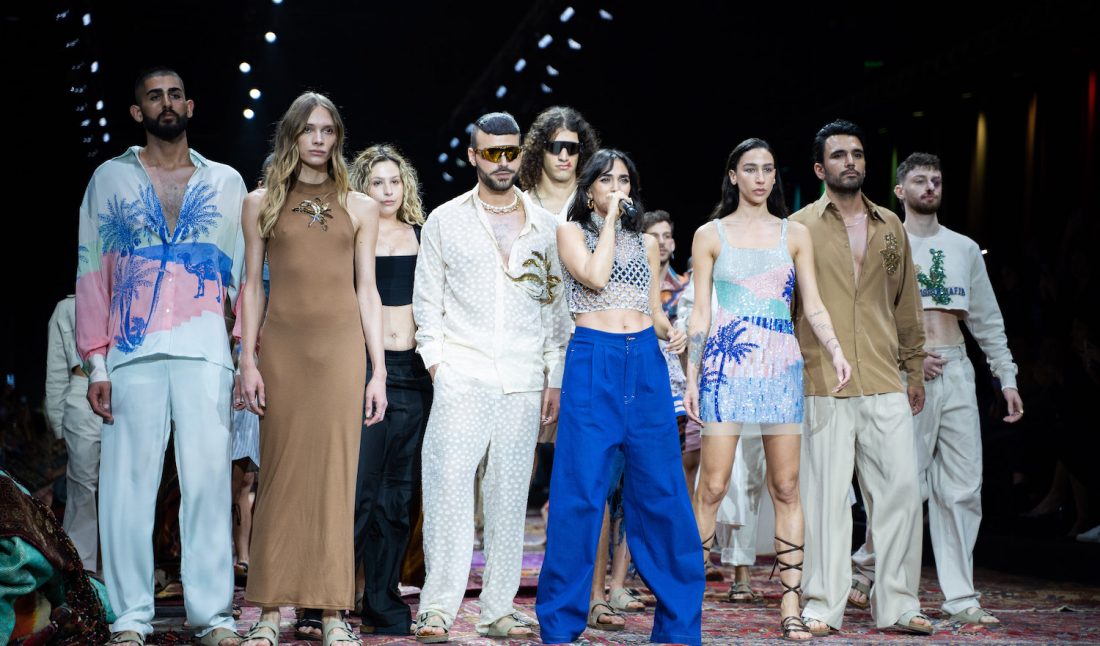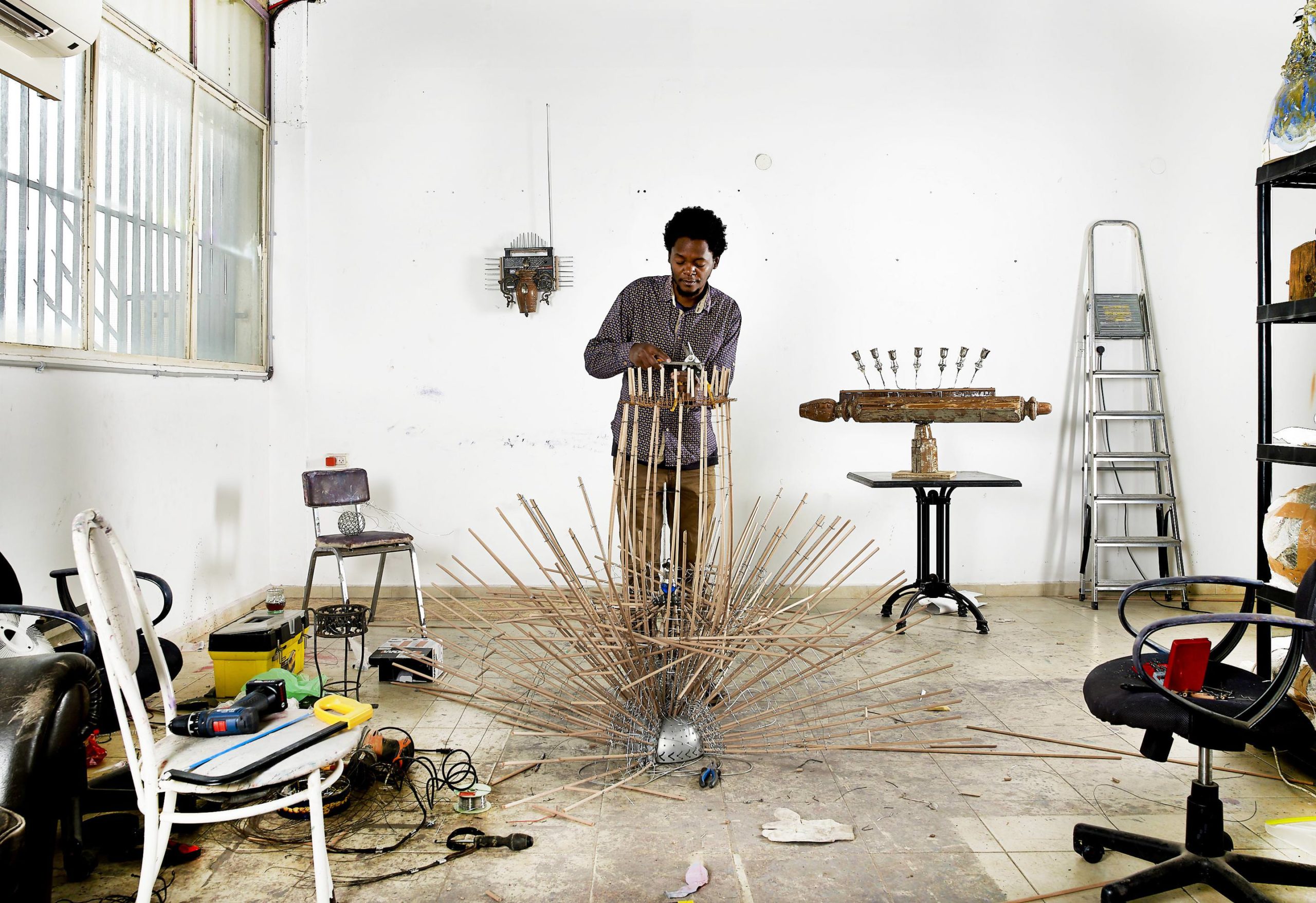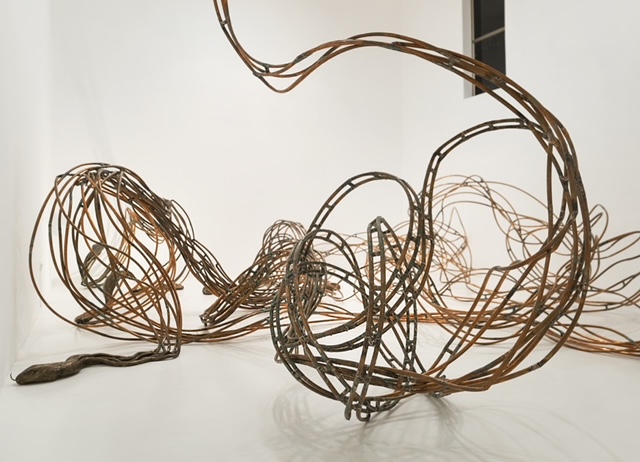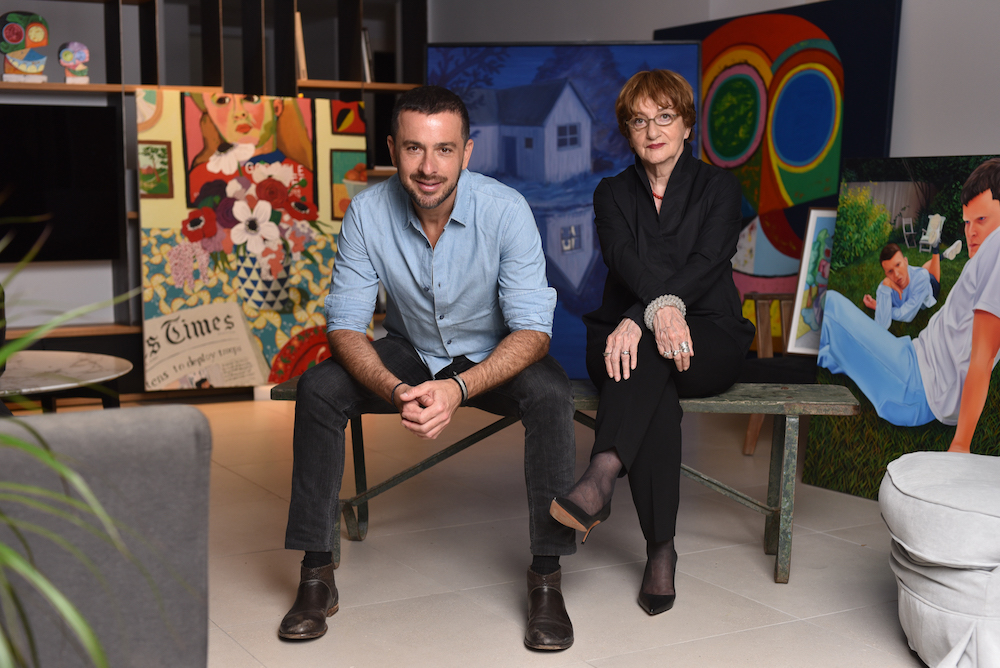Fashion in general, and fashion weeks in particular, used to be a sweet escape, a commercial break if you like, from the alarming reality we live in today—wars, earthquakes, and continuous protests all over the capitals of the world. This challenging moment, however, calls for taking a stand wherever we can.
Recently, against the backdrop of Israel’s complex political climate, where protests and strikes have been occurring all over the country for weeks, Kornit Fashion Week FAC Tel-Aviv 2023 (March 19-22, 2023) took paid tribute to democracy, tolerance, and equality.
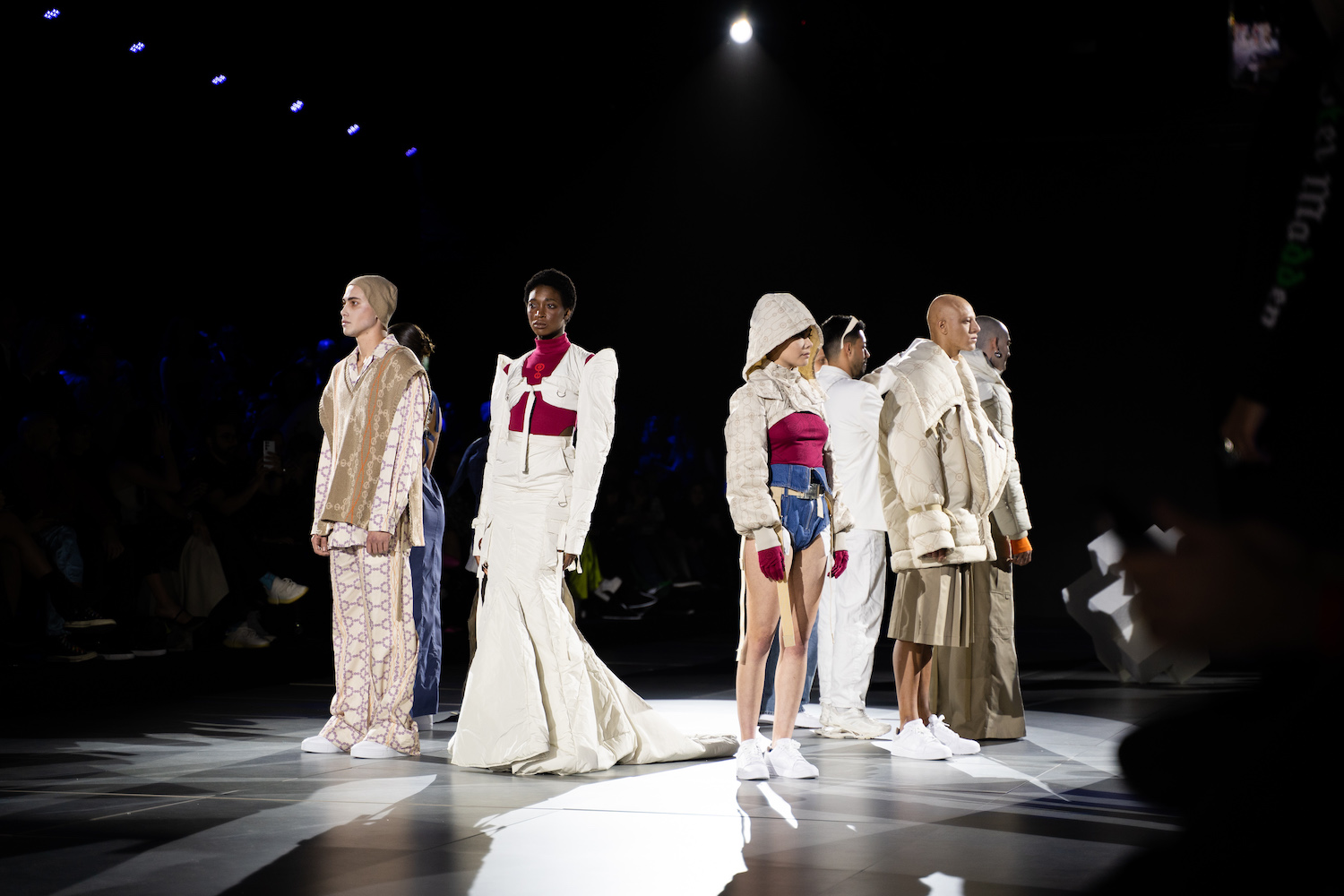 Courtesy of Placebo, photo by Ofir Perez.
Courtesy of Placebo, photo by Ofir Perez.
Kornit was held for the 12th year by entrepreneur and producer Motty Reif, presenting 28 shows by leading Israeli designers who joined hands to launch a new era of fashion using the innovative FAC project—Fashion Agenda Community. Rief, a member of the City Council of Tel Aviv-Yafo, issuing matters of welfare in the city such as the Committee Against Violence and women’s rights, initiated the concept as an extension of the principles that he and Kornit have established throughout the years, focusing on sustainability and inclusivity, especially within beauty standards and ideals. It combined panels of experts in a variety of social issues that lack awareness, from the fields of environmental recycling and sustainability to women’s health, ageism, entrepreneurship, sexuality, shame, and abuse.
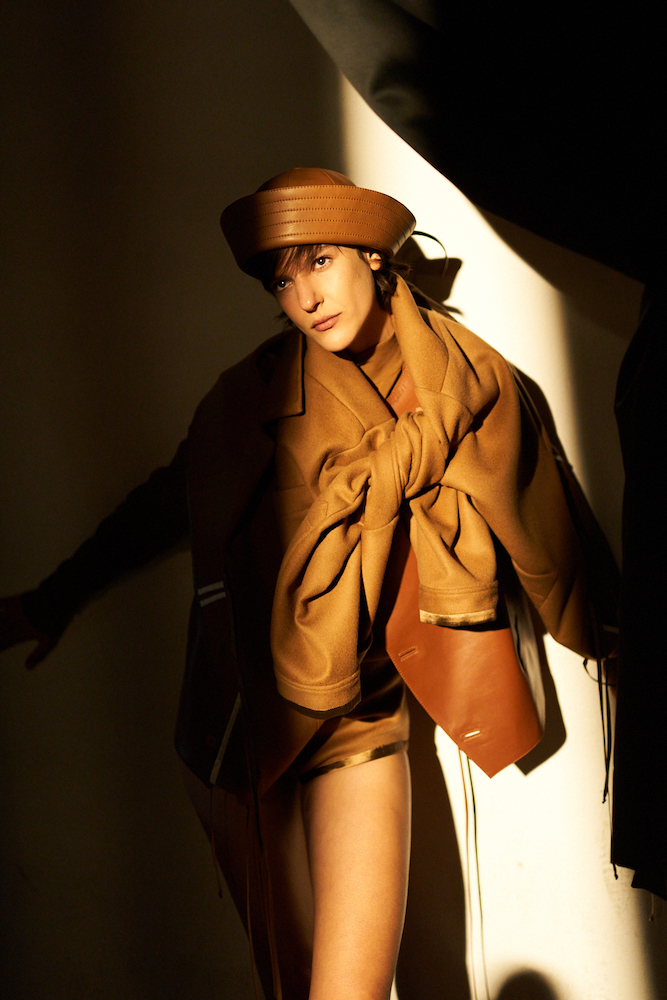 Courtesy of Aharon Genish, photo by Rachel Friedman.
Courtesy of Aharon Genish, photo by Rachel Friedman.
The opening show by David Weksler left those present on the edge of their seats. At first glance, it seemed like a youth rebellion—garments in bold colors, some in dense prints, silver pins, ponytails, buns, and make-up applied under the eyes reminiscent of tears, or two lines in black and white drawn before going into battle, and some very low waisted jeans. Not so long after, it clicked while witnessing a model in a policeman’s uniform handing reports to the audience. Clashes among the figures and a table and chair placed on the runway implied governmental corruption. It was loud and clear: the runway reflected the local arena—the streets of Tel Aviv nowadays.
Chaos ruled the runway. The randomness of prints and the rough-cut jeans, almost suggesting DIY techniques, covered in photomontages and assemblages, readymades, unprocessed material, and elements from the Israeli army, expressed nonsense, irrationality, and anti-bourgeois. It all echoed the Dadaists of the early 20th century, who fought against the social, political, and cultural ideas of their time, and were very much known for their discontent toward violence, war, and nationalism. The designer, who specializes in textile and print developments, is involved in sustainable fashion. Weksler graduated with a bachelor’s degree from Shenkar in fashion design and has a master’s degree from Central Saint Martins in London. They collaborated with Kornit Digital in digital printing and used artificial intelligence to offer us a visit to a futuristic post-apocalyptic world, a postmodern mishmash followed by constant consumption, wearing junk, and the consequences of the late capitalist era.
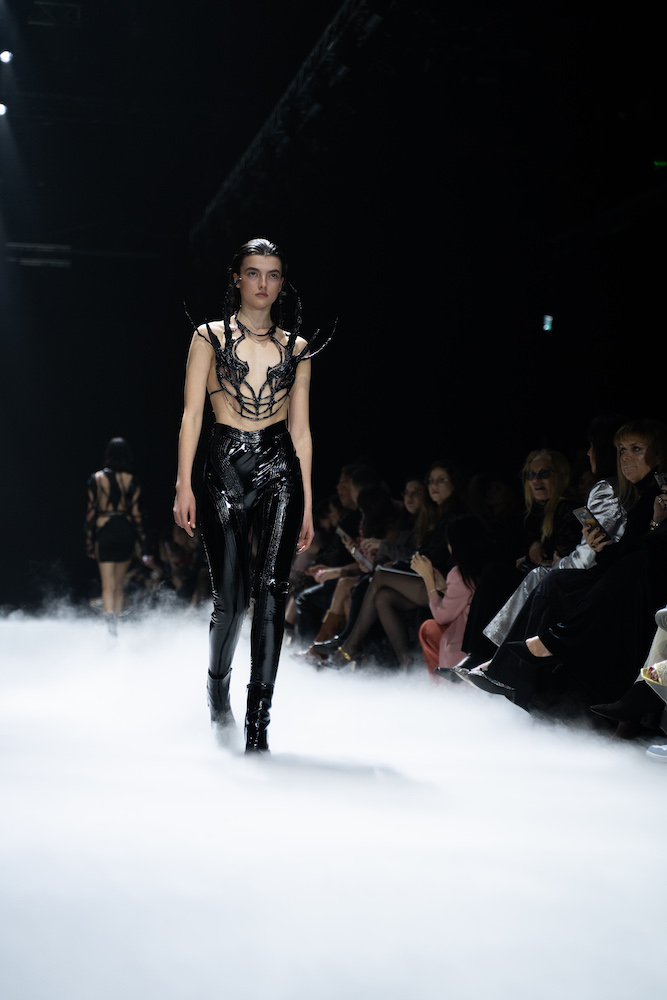 Courtesy of Alon Livne, photo by Ofir Perez.
Courtesy of Alon Livne, photo by Ofir Perez.
Later that day, the prestigious Swedish digital fashion brand Placebo, founded by fashion designer Roei Dehri, continued the plot line with its new collection, BABYLON—a hybrid collection that unfolds the story of the Tower of Babel, an origin myth that is meant to explain why the world’s people speak different languages and is in many ways a parable for unity over division. The fashion house used the tower as a metaphor for the internet and how people can blur physical boundaries and collaborate through technology. The collection includes a “fusion” and “confusion” of languages and different fashion styles, including street, tailoring, and evening glam, wrapped and treasured with details and silhouettes inspired by the useful outfits of builders and construction workers.
The execution of the designs integrates technology and production processes. Using 3D technology to skip the sample stage, calculating the materials, and designing the prints on fabrics, the brand adhered to its own values of sustainability while using Kornit’s printing technology on different fabrics. The collection challenged traditional fashion norms and blurred the lines between physical and digital fashion, resulting in unique creations that cater to both technology and fashion enthusiasts.
The fashion house used AI technology as a creative tool for dialogue and inspiration research, and for the first time in history incorporated Boyo‘s pioneering NFT technology into physical clothing. Customers can “tap to mind” by scanning the tag with their mobile device, allowing them to reveal details about the garments, view their digital representation, and buy the NFT version of the garment. Integrating blockchain technology into the collection also creates transparency, ownership, and verification of physical and digital assets.
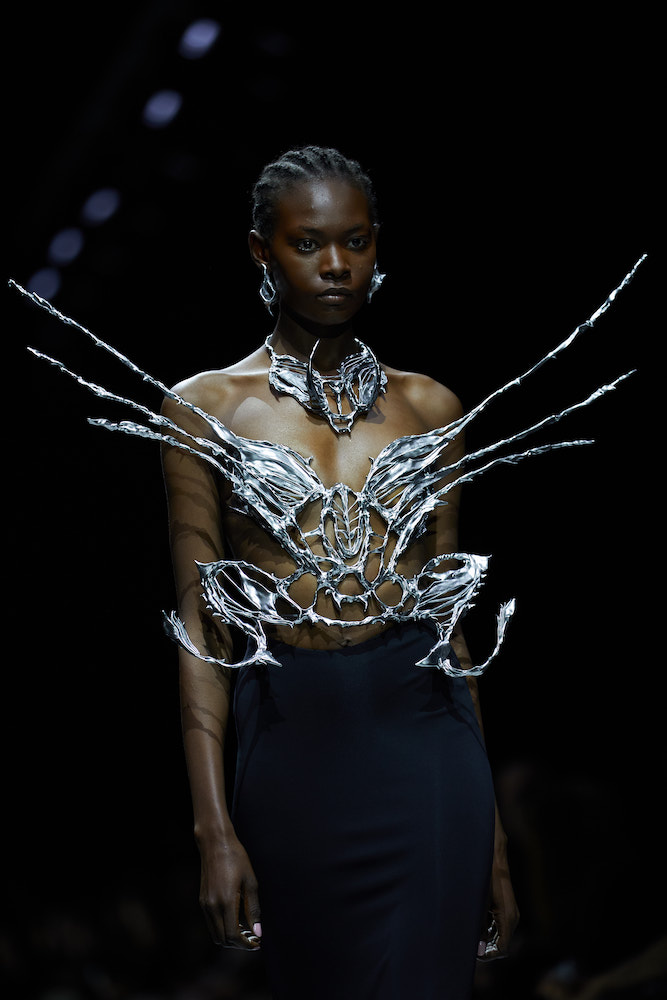 Courtesy of Alon Livne, photo by Shlomi Aldo.
Courtesy of Alon Livne, photo by Shlomi Aldo.
It is no surprise, as Placebo is known for revolutionizing the way people perceive fashion. With its innovative use of advanced technologies and blockchain technologies, Placebo believes that fashion is the hardware for the technology interface and is taking a significant step forward in merging the two while creating fashion for Metaverse platforms, games, as well as physical products. The collection was produced in collaboration with Studio M.A. in the design and modeling of the Tower of Babel, with Replica Studio in the environment design and 3-D art, along with Yosef E. Shein Mizrahi and the Kadmon band composing and producing the music.
The show that closed the day, in the festive gala evening, was Alon Livne’s “Exocet” winter 2023 collection, which was named after the French missile that was used mainly in the Falkland War and is known for the great destruction it caused. Like the ones before, the collection referred to a post-apocalyptic world built from the ruins, a chaos out of which a new order is created. The models roamed around the clouds that hovered above the runway, providing the crowd with an out-of-this-world experience. The collection consisted of 34 clothing sets, among which you can find tailored jackets, pants, and cocktail and evening dresses. In every look, Livne’s style gets noticed: geometric cuts, asymmetry, and a sophisticated look in complex and unique cuts. The dominant materials of the collection were combinations of the organic versus the synthetic—leather, silk, vinyl, and jersey. The looks were accompanied by unique handcrafted jewelry and sunglasses that were created by the designer especially for the collection, conveying the futuristic idea of the day.
The designers of the second day served as a representation of a new alternative—a positive one. Hagar Alembic, who was presented the night before with a lifetime achievement award for her work throughout 35 years of fashion, is considered one of the most respected and successful Israeli designers in the world; the company that bears her name is the leading and largest exporter in the Israeli fashion industry. Alembika opened the second day of the shows with fanfare and a journey that included video art, a dance performance, and works of art that celebrated sustainability, femininity, and uncompromising creativity. The display that presented the brand’s summer collection, as well as some items from the next winter collection, invited the viewer to dive into the expressionist world of the designer. Alembika showed us how the Israeli landscape is perceived through her gaze: items inspired by the city, an abstract urban exploration of lines, circles, and graphic games of black and white, followed by nature’s representation in colors, spots, and shapes in a nostalgic color-block.
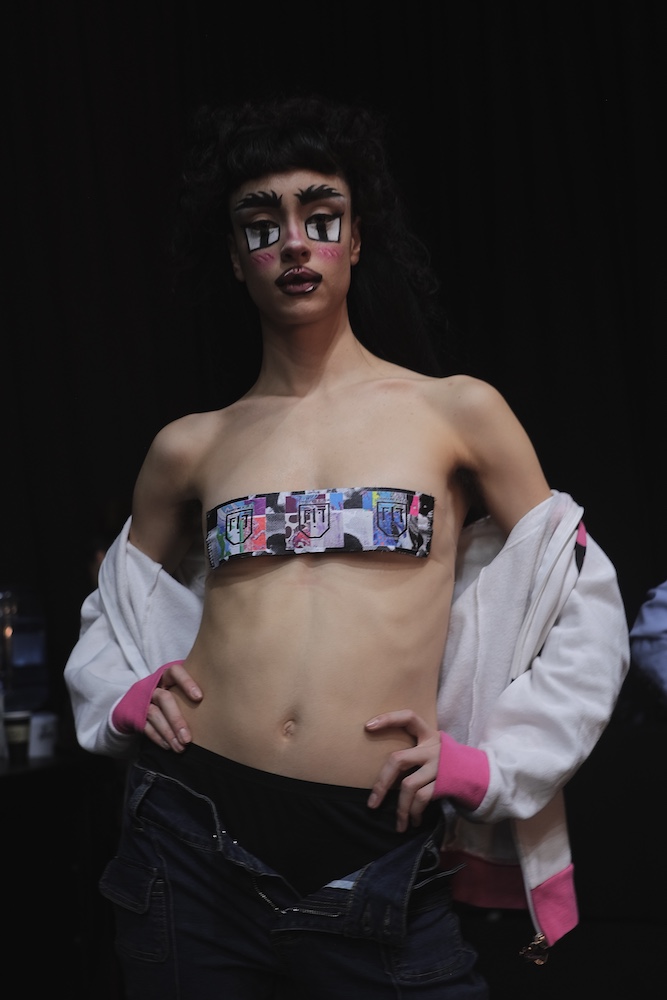 Courtesy of David Weksler, photo by Viktor Pleskov.
Courtesy of David Weksler, photo by Viktor Pleskov.
At the center was Alembika’s woman, the one whose clothes are meant to give her personal expression, freedom, movement, and joy through their colorfulness. Women of a wide range of sizes and ages walked side-by-side and made each of the attendees find themselves among the marching figures. Another celebration of femininity and inclusiveness was presented by the designers Naama and Tovala Hasin for the Tovala+ brand. The brand’s summer 2023 collection was a love letter to all people. Acceptance was the term of the hour while 52 models wore colorful, iridescent, and shimmering looks where the three symbols of all religions are intertwined, similar to the familiar tattoo found on the forehead of Hasin. The show indulged in nostalgia for the kibbutz days, yearning for better times, and ended with the sound of the song Democracy from the Israeli movie Kazablan (1973).
Among the wide variety of designers who tried to find the secret recipe for the complex Israeli identity, it seems like House of Jaffa got it right. The brand, founded by the duo of designers Golan Friedman and Eddie Gavrilidis, succeeded in taking the local Mediterranean atmosphere and translating it into a modern, free, and sustainable wardrobe. The runway that welcomed us was piled with carpets, new and old, in Middle Eastern styles inspired by the Jaffa flea market, hinting at the collection that was about to be revealed. Women and men began walking in oversized patterns, originating in menswear that was softened by the use of flowing fabrics, prints, and delicate romantic hand embroidery inspired by local scenery and traditional crafts. The elegance of rich fabrics and embroidery caused a feeling of inexplicable longing for a place of which some of us are not even familiar.
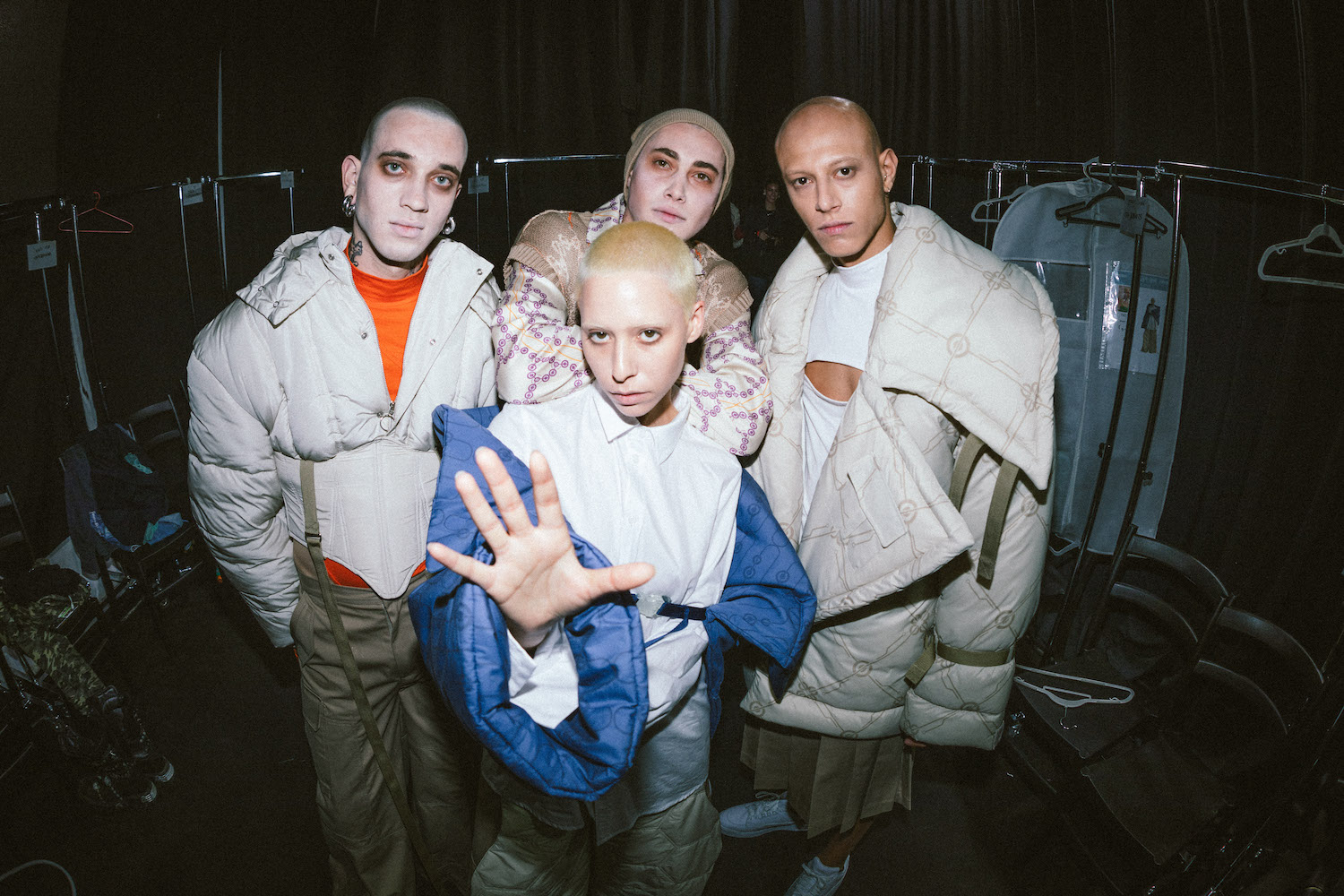 Photo by Danielle Sinai Shvadron, courtesy of Placebo.
Photo by Danielle Sinai Shvadron, courtesy of Placebo.
The marchers wore glasses from the new Oakley collection that added a sharp and modern vibe and gave the wearer a protective shell that felt almost like a helmet or mask. At the feet of the walkers were appropriate Teva sandals in desert tones that really speak to the brand’s language of comfort and effortless beauty that reflect the Tel Avivian spirit. Part of the women’s collection presented this year—such as striped prints and cactus flowers on cotton, or satin maxi dresses and fringe skirts—is an exclusive collaboration with Razili and can be found in stores. The collection confronts social concepts of youth versus maturity and gender concepts of masculinity, femininity, and queerness while using the right amount of tradition and making it their own. It is without a doubt that House of Jaffa broke through society’s whims while creating an updated version of the Middle East, one that celebrates a free, modern, and unapologetic lifestyle. One of the greatest missions of the current Israeli Fashion Week was to break the silence, and to talk out all the injustices that were taboo in such a conservative society.
Aharon Genish‘s abusive childhood was one of those untold stories waiting to be uncovered. His collection is based on his personal journey as a child in an orthodox Jewish family that experienced abuse. Its biblical name, Kumi Ori Ki Ba Orech, deals with the rise of light over darkness. The first models wore head-to-toe black or white dresses. Shirts and suits were combined with tights and pointed shoes. All included a lot of tulle and lace fabrics. In some looks, the models were holding dolls, reminiscent of the dramatic porcelain dolls that plant discomfort, as if taken out of a horror scenario. Later on, the music changed and a more diverse color palette, prints, and different types of fabrics appeared. The brown leather vest and shorts, a black jacket and shorts with a stunning decoration of white chrysanthemums, and flowing satin fabrics with pleats and refreshing cuts left us all breathless. But despite the beautiful garments, every person in the room could sense the feeling of discomfort. The blank stare of the models was carefully planned and no eye was left dry.
Genish’s clothes are his own interpretation of the personal events that he lived through. He expresses some with the help of symbolic elements associated with various rituals from his childhood. Particularly striking is the representation of the kitel—an item of clothing from the Hasidic world that is usually worn at festive times and at weddings. The kitel for the wearer is a symbol of renewal and excitement and sometimes symbolizes a transition to a different and positive station in life. But the question arises, will this station be a life of happiness, or is it just a luxurious shroud for a person in a prison house? And yet, Aharon sets a narrative of hope that describes an exit from various crises and situations to personal redemption, flourishing, and renewal.
 Courtesy of Aharon Genish, photo by Rachel Friedman.
Courtesy of Aharon Genish, photo by Rachel Friedman.






